Find the number of terms in the expansion of x y 3 x y 3 2 x y 3 x y 3 2 = x 2 y 2 3 2 = x 2 y 2 6No of terms in the expansion = n4 Binomial Expansions 41 Pascal's riTangle The expansion of (ax)2 is (ax)2 = a2 2axx2 Hence, (ax)3 = (ax)(ax)2 = (ax)(a2 2axx2) = a3 (12)a 2x(21)ax x 3= a3 3a2x3ax2 x urther,F (ax)4 = (ax)(ax)4 = (ax)(a3 3a2x3ax2 x3) = a4 (13)a3x(33)a2x2 (31)ax3 x4 = a4 4a3x6a2x2 4ax3 x4 In general we see that the coe cients of (a x)nThe base is X;
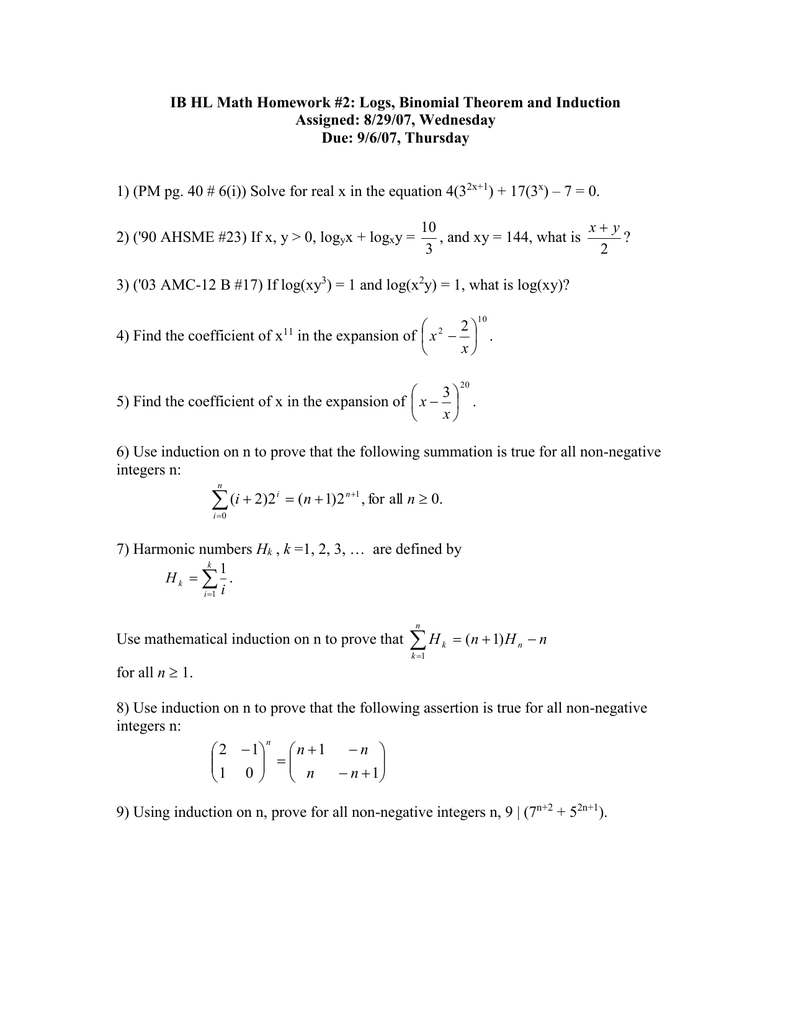
Ib Hl Math Homework 2 Logs Binomial Theorem And Induction
(x+y+z)^3 expansion
(x+y+z)^3 expansion-The base is Y;Result A sum containing 2 terms;
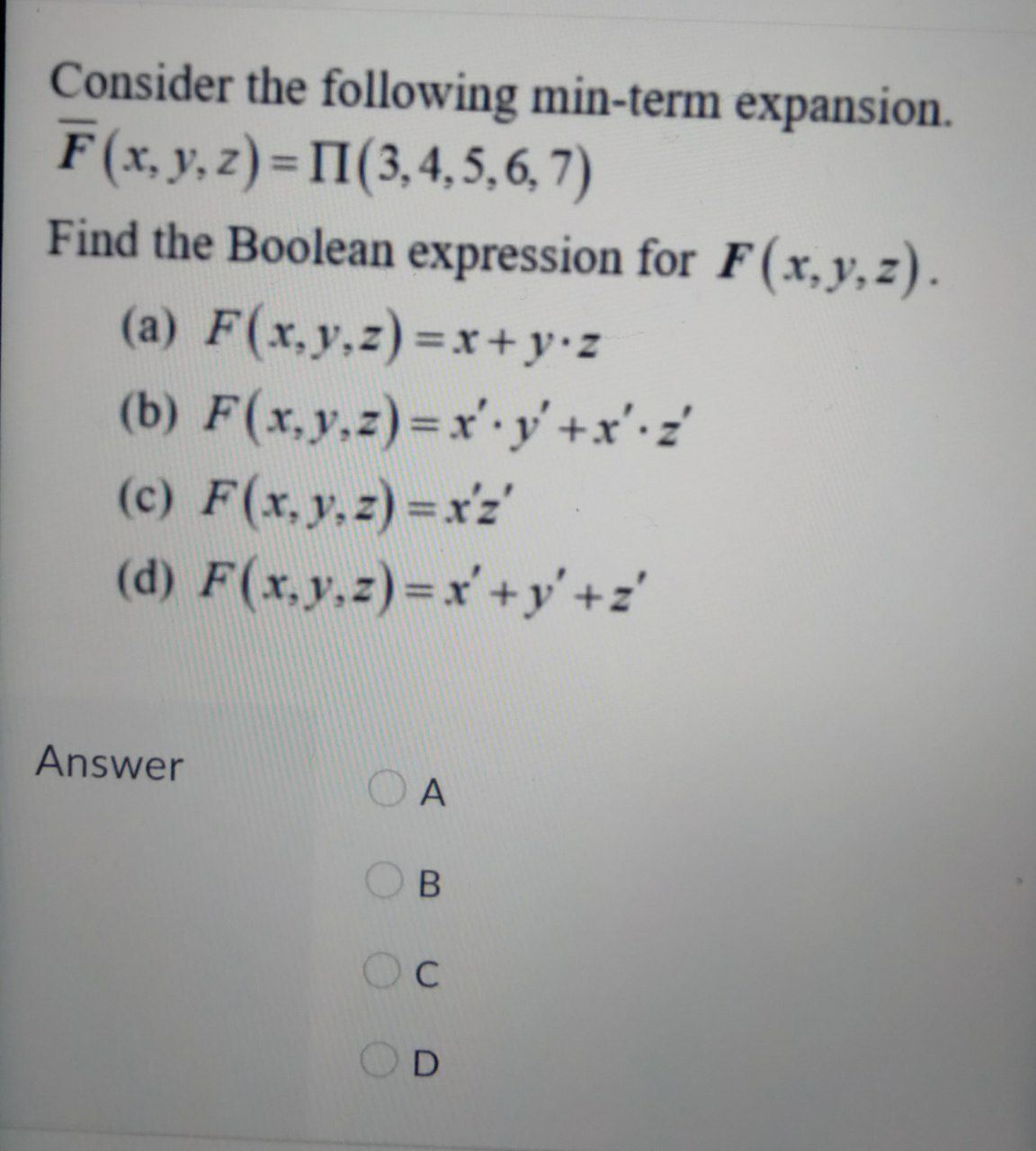



Answered Consider The Following Min Term Bartleby
Massimiliano The rule is \displaystyle{\left({a}{b}\right)}^{{3}}={a}^{{3}}{3}{a}^{{2}}{b}{3}{a}{b}^{{2}}{b}^{{3}} So \displaystyle{\left({x}{2}{y}\right)}^{{3}}={x}^{{3}}{3}{\left({x}\right)}^{{2}}{\left({2}{y}\right)}{3}{x}{\left({2}{y}\right)}^{{2}}{\left({2}{y}\right)}^{{3}}=The first term of the sum is a power;The exponent is two;
If you consider that LCM(2,3)=6 a = x^4/y^3 b = y^2/2x You want terms of the form a^2b^3 or a^4b^6, Since we have a 10th power expansion, the exponents must add to 10, so we are looking for a^4b^6 Example 7 Find the coefficient of x6y3 in the expansion of (x 2y)9 We know that General term of expansion (a b)n is Tr1 = nCr an–r br For (x 2y)9, Putting n = 9 , a = x , b = 2y Tr 1 = 9Cr (x)9 – r (2y)r = 9Cr (x)9 – r (y)r (2)r We need to find coefficient of x6 y3 Comparing yr = y3 r = 3 Putting r = 3 in (1) T31 = 9C3 x9Here is a music track from the exclusive FZero X EXpansion Kit This time, it is a new track called "Rollercoaster", which is found in "Sand Ocean 3" and "
X y is a binomial in which x and y are two terms In mathematics, the cube of sum of two terms is expressed as the cube of binomial x y It is read as x plus y whole cube It is mainly used in mathematics as a formula for expanding cube of sum of any two terms in their terms ( x y) 3 = x 3 y 3 3 x 2 y 3 x y 2Expand (xy)^3 full pad » x^2 x^ {\msquare} \log_ {\msquare} \sqrt {\square} \nthroot \msquare {\square} \le \geBinomial Theorem Formula Problem 1 Use the formula for the binomial theorem to determine the fourth term in the expansion (y − 1) 7 Show Answer Problem 2 Make use of the binomial theorem formula to determine the eleventh term in the expansion




How To Expand Using The Identity X Y 3 X3 Y3 3x2y 3xy2 Youtube
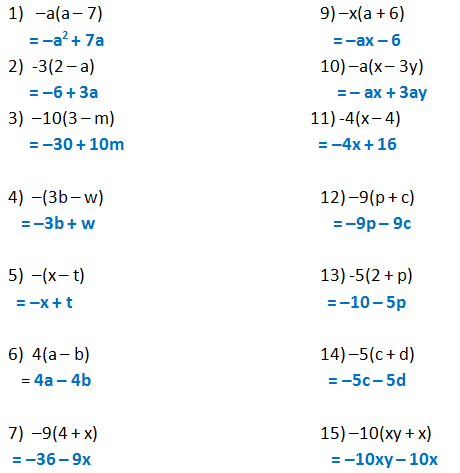



Form 2 Unit 2 Lesson 5 Expansion Of Algebraic Expression Brilliant Maths
The number of terms in the expansion of x4y 3 x4y 3 2 is 6 7 8 12 x 4y 3 x – 4y 3 2 = x 2 – 4y 2 6 = x 2 – 16y 2 6No of terms in the expansioIn the denominator for each term in the infinite sum HistoryBy signing up, you'll get thousands of stepbystep solutions to your homework questions You can also ask your




X Y 2 3 Find The Expansion Of The Following Brainly In
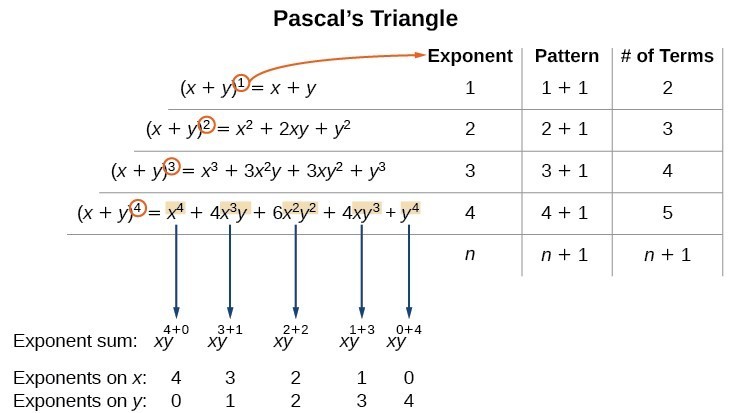



Using The Binomial Theorem College Algebra
Compute answers using Wolfram's breakthrough technology & knowledgebase, relied on by millions of students & professionals For math, scienceX^3 y^3 z^3 3x^2y 3xy^2 3x^2z 3z^2x 3y^2z 3z^2y 6xyz Lennox Obuong Algebra Student Email obuong3@aolcom1 2 1 for n = 2 the x^2 term is the rightmost one here so we'll get 1 times the first term to the 0 power times the second term squared or 1*1^0* (x/5)^2 = x^2/25 so not here 1 3 3 1 for n = 3 Squared term is second from the right, so we get 3*1^1* (x/5)^2 = 3x^2/25 so not here 1



How To Expand X Y 7 Quora



Http Mrscolpittswss Weebly Com Uploads 3 7 0 4 Pc12 Sol C08 8 6 1 Pdf
Using binomial theorem, expand each of the following (3√x3√y)^6 asked 3 days ago in Binomial Theorem by Kanishk01 (161k points) binomial theorem;Martin Berz , in Advances in Imaging and Electron Physics, 1999 541 Differentiating ODE Solvers Intuitively, the most direct method for obtaining Taylor expansions for the flow of an ODE is to recognize that a numerical ODE solver describes a functional dependency between initial conditions and final conditions Thus, by replacing all arithmetic operations in it by the corresponding onesThe Binomial Theorem is the method of expanding an expression which has been raised to any finite power A binomial Theorem is a powerful tool of expansion, which has application in Algebra, probability, etc Binomial Expression A binomial expression is an algebraic expression which contains two dissimilar terms Ex a b, a 3 b 3, etc




Ppt The Binomial Theorem Powerpoint Presentation Free Download Id
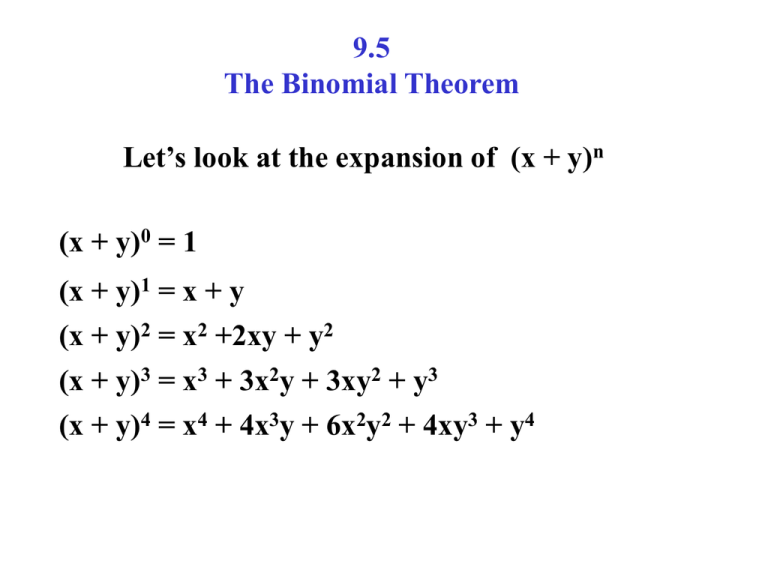



9 5 The Binomial Theorem
The above expansion holds because the derivative of e x with respect to x is also e x, and e 0 equals 1 This leaves the terms (x − 0) n in the numerator and n!So to find the expansion of (x − y)3, we can replace y with (−y) in (x y)3 = x2 3x2y 3xy2 y31 Answer The coefficient of x3y2 in (x−3y)5 is 90 What is the coefficient of X?




Binomial Theorem Wikipedia




Ib Hl Math Homework 2 Logs Binomial Theorem And Induction
Expand Using the Binomial Theorem (XY)^4 (X Y)4 ( X Y) 4 Use the binomial expansion theorem to find each term The binomial theorem states (ab)n = n ∑ k=0nCk⋅(an−kbk) ( a b) n = ∑ k = 0 n n C k ⋅ ( a n k b k) 4 ∑ k=0 4!Answer to How to expand x^3y^3?The formula is (xy)³=x³y³3xy(xy) Proof for this formula step by step =(xy)³ =(xy)(xy)(xy) ={(xy)(xy)}(xy) =(x²xyxyy²)(xy) =(xy)(x²y²2xy
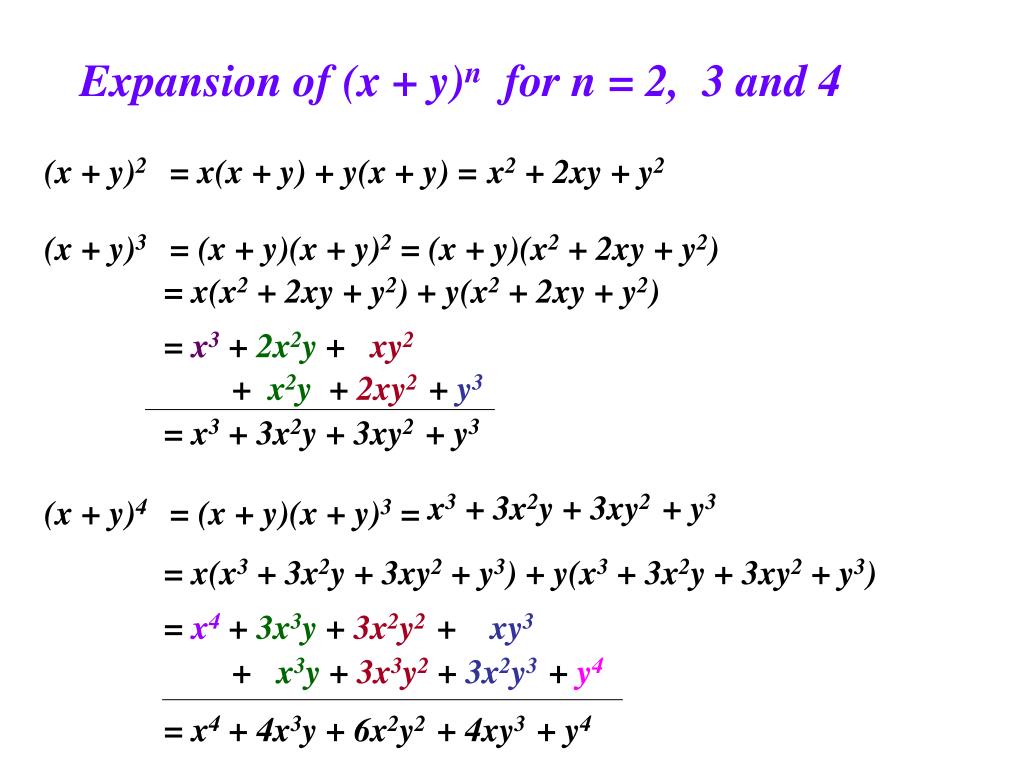



Ppt The Binomial Theorem 1 Powerpoint Presentation Free Download Id




16 Pokemon Xy Generations Expansion Set Caterpie 3 5e9 Ebay
The Binomial Theorem Here is the expansion of (x y)n for n = 0, 1,, 5 (x y)0 = 1 (x y)1 = x y (x y)2 = x2 2xy y2 (x y)3 = x3 3x2y 3xy2 y3 (x y)4 = x4 4x3y 6x2y2 4xy3 y4 (x y)5 = x5 5x4y 10x3y2 10x2y3 5xy4 y5 Look familiar? The general term in the expansion of is given by (i) We have to find the coeffcient of Putting r=3 in (i), we getSolution Expanding the binomial using the binomial theorem formula, we have Therefore, the coefficient for x4y3 x 4 y 3 is −25 − 25




6 Find The First Four Terms In The Expansion Xy 2 Gauthmath




Learn Algebraic Identity Of X Y And X Y In 3 Minutes
To find the coefficient of x 7 y 2 in the expansion of (x 2y) 9 Formula Used A general term, T r1 of binomial expansion (x y) n is given by, Now, finding the general term of the expression, (x 2y) 9, we get The value of r for which coefficient of x 7 y 2 is defined R = 2 Expand (1/xy/3)^3 solve it fastly density1 density1 Math Secondary School answered Expand (1/xy/3)^3 solve Row 10 1 10 45 1 210 1x^10 10x^9y^1 45x^8y^2 1x^7y^3 If you do it by combinations, you want 10nCr7 = 1 (the 10 comes from row 10, determined by the sum of the two exponents, the 7 comes from the exponent of the x




Using The Binomial Theorem College Algebra




9 5 The Binomial Theorem Lets Look At
Expand (x y z)^10 Extended Keyboard;The exponent is two; 6 Preexpansion, there are 8 factors of 2 x − y 5 From those 8 factors, choose the 3 that contribute to the x 3, from the remaining 5 factors, choose the 4 that will contribute to y 4 There is only 1 factor left so it chooses itself
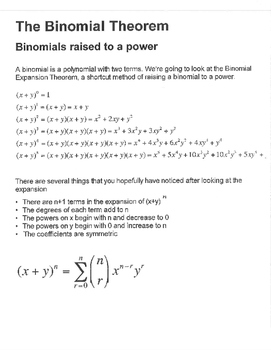



Binomial Expansion Theorem Notes Guided Examples Practice X Y Tpt
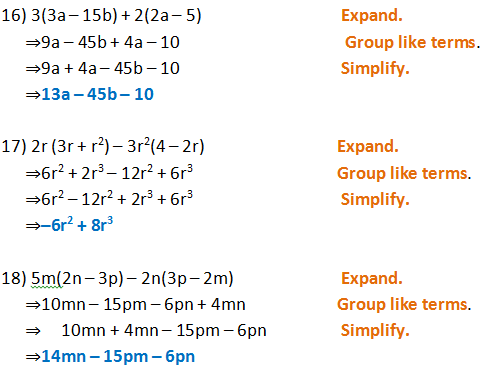



Form 2 Unit 2 Lesson 5 Expansion Of Algebraic Expression Brilliant Maths
In the expression, if we replace y with (− y), we will get the identity x 3 − y 3 Now, let's further verify this numerically with an example To verify, let's take the values for x and y and put in the LHS and RHS of the identity243x 5 810x 4 y 1080x 3 y 2 7x 2 y 3 240xy 4 32y 5 Finding the k th term Find the 9th term in the expansion of (x2y) 13 Since we start counting with 0, the 9th term is actually going to be when k=8 That is, the power on the x will 138=5 and the power on the 2y will be 8TAYLOR SERIES Expand x^2y3y2 in the powers of x1 and y2 up to 3 degree terms Watch later Share Copy link Info Shopping Tap to unmute If playback doesn't begin shortly, try




Expand 1 X Y 3 3 Novocom Top




Question 1 1 What Is The Coefficient Of Roy2 In The Chegg Com
X exponentiated by two plus negative Y raised to the power two ;(xyz)^3 put xy = a (az)^3= a^3 z^3 3az ( az) = (xy)^3 z^3 3 a^2 z 3a z^2 = x^3y^3 z^3 3 x^2 y 3 x y^2 3(xy)^2 z 3(xy) z^2 =x^3 y^3 z^3 3 x⋅ ( X) 4 k ⋅ ( Y



Illustration Of 3 D Decap Allocation A 3 D Placement B Download Scientific Diagram




16 Pokemon Xy Steam Siege Expansion Set Base 3 Hoppip
What is the x 2 y 3 coefficient when expanding X − y 5?Key Takeaways Key Points According to the theorem, it is possible to expand the power latex(x y)^n/latex into a sum involving terms of the form latexax^by^c/latex, where the exponents latexb/latex and latexc/latex are nonnegative integers with latexbc=n/latex, and the coefficient latexa/latex of each term is a specific positive integer depending on latexn/latex( 4 k)!




How Do You Expand The Binomial X Y 5 Socratic




4 Sealed Pokemon Xy Evolutions 3 Card Booster Packs All 4 Artworks Ebay
Binomial Expansions Binomial Expansions Notice that (x y) 0 = 1 (x y) 2 = x 2 2xy y 2 (x y) 3 = x 3 3x 3 y 3xy 2 y 3 (x y) 4 = x 4 4x 3 y 6x 2 y 2 4xy 3 y 4 Notice that the powers are descending in x and ascending in yAlthough FOILing is one way to solve these problems, there is a much easier wayTake the square root of both sides of the equation x^ {2}y^ {2}3=0 Subtract 3 from both sides y^ {2}x^ {2}3=0 Quadratic equations like this one, with an x^ {2} term but no x term, can still be solved using the quadratic formula, \frac {b±\sqrt {b^ {2}4ac}} {2a}, once they are put in standard form ax^ {2}bxc=0 ML Aggarwal Class 9 Solutions for ICSE Maths Chapter 3 Expansions Chapter Test Question 1 Find the expansions of the following (i) (2x 3y 5) (2x 3y – 5) (ii) (6 – 4a 7b) 2 (iii) (7 – 3xy) 3 (iv) (x y 2) 3




How Can We Expand X Y 1 2 Youtube



Alg2 10 5 Part 2 Binomial Expansion Mrsb Schooltube Safe Video Sharing And Management For K12
Explanation (x −y)3 = (x − y)(x −y)(x −y) Expand the first two brackets (x −y)(x − y) = x2 −xy −xy y2 ⇒ x2 y2 − 2xy Multiply the result by the last two brackets (x2 y2 −2xy)(x − y) = x3 − x2y xy2 − y3 −2x2y 2xy2 ⇒ x3 −y3 − 3x2y 3xy2 About this tutor › About this tutor › (xy)3expanded has 4 terms, 1 more than the exponent, x3x2y xy2and y3 x is decreasing from 3 to 0 from left to right, as y increases from 0 to 3 Any number or variable to the 0 power is 1 Then you need the coefficients for each of the 4 termsIn elementary algebra, the binomial theorem describes the algebraic expansion of powers of a binomial According to the theorem, it is possible to expand the polynomial n into a sum involving terms of the form axbyc, where the exponents b and c are nonnegative integers with b c = n, and the coefficient a of each term is a specific positive integer depending on n and b For example, 4 = x 4 4 x 3 y 6 x 2 y 2 4 x y 3 y 4 {\displaystyle ^{4}=x^{4}4x^{3}y6x^{2}y



How To Expand The Binomial X Y 10 Quora




Find The Coefficient Of X 2 Y 3 Z 4 In The Expansion Of Ax By Cz 9 Youtube
Expand (x1)^3 Expand Calculator Symbolab This website uses cookies to ensure you get the best experience By using this website, you agree to our Cookie Policy Learn more Accept Solutions Graphing Practice Geometry beta⋅(X)4−k ⋅(Y)k ∑ k = 0 4 4!The number of terms in the expansion of (xyz)10 is (A) 11 (B) 33 66 (D) 1000 Check Answer and Solution for above question from Mathematics in B




Solved Find The Expansion Of X Y 4 A Using C




Binomial Coefficients And The Binomial Theorem
Welcome to Sarthaks eConnect A unique platform where students can interact with teachers/experts/students to getWe know that (xy) 3 can be written as (xy)(xy)(xy) We know that (xy)(xy) can be multiplied and written as x 2xy yx y 2 (xy) = x 22xy y 2 (xy) = x 32x 2 y xy 2yx 2 2xy 2y 3 = x 33x 2 y 3xy 2y 3 Answer (xy) 3 =x 33x 2 y 3xy 2y 3(x y) 3 = x 3 3x 2 y 3xy 2 y 3 (x y) 4 = x 4 4x 3 y 6x 2 y 2 4xy 3 y 4;
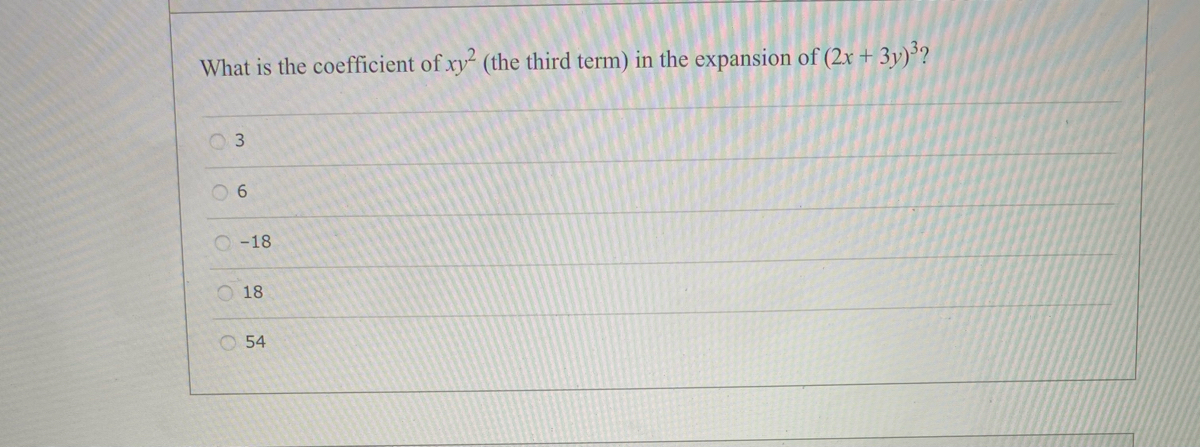



Answered What Is The Coefficient Of Xy The Bartleby




3 6 The Binomial And Multinomial Theorems
Show, by left side, that $$\frac{x^3y^3}{xy} = x^2xyy^2,$$ or $$\frac{x^3y^3}{x^2xyy^2} = xy$$ You may read about "Long Division of Polynomials" See also LINK for knowing the processExpand (xy)^3 (x y)3 ( x y) 3 Use the Binomial Theorem x3 3x2y3xy2 y3 x 3 3 x 2 y 3 x y 2 y 3The second term of the sum is equal to a negative power;



Exercise 1 4 X 5 Prove The Following Using Logic Manipulations Quote At Each Step The Applied Law X Y X Y Y 2 X Y Xy X Y Course Hero
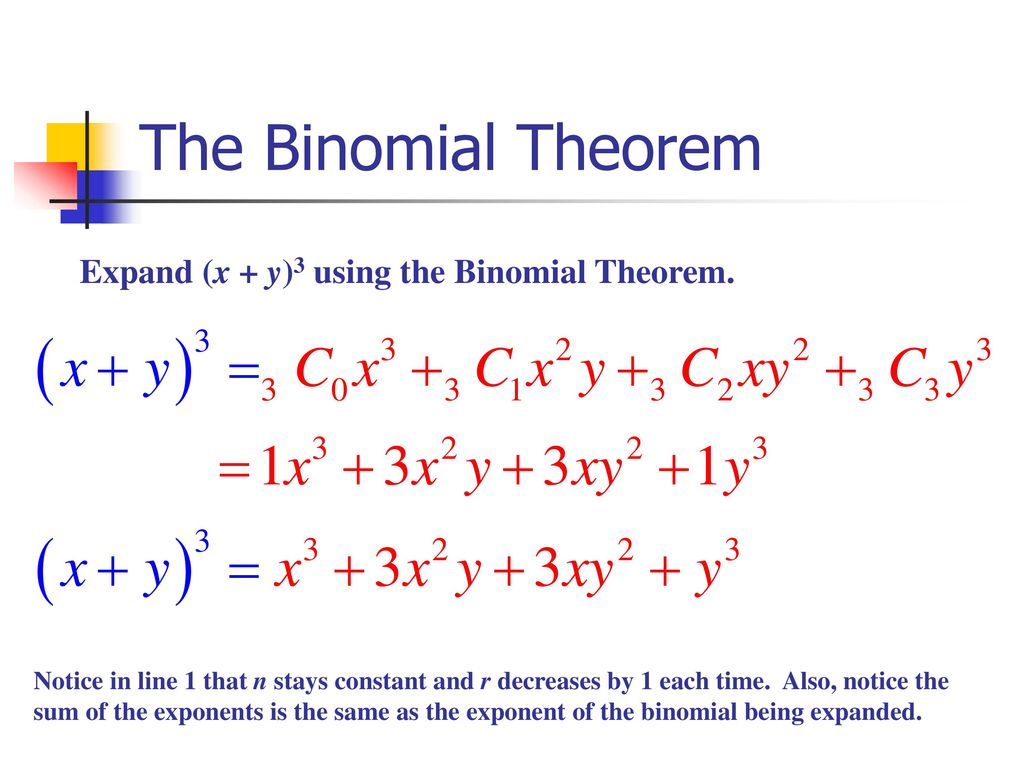



Section 8 5 The Binomial Theorem Ppt Download
Find the coefficient of x^5y^7 in the expansion of (5x2y)^12 12 (x)^5 (2y)^7 3 My answer which i got wrong is 2x^5(128y^7)= x^5y^7 Physics A steel wire, 150 m long at 10°C, has a coefficient of linear expansion of 11 ´ 106/C° Give It seems more like this should be an inequality (xy)^3 (yz)3 (zx)^3 >= 3 (xy) (yz) (zx) But that is not the question set Please note that this is the first chapter and all that has been covered is basic number theory, rational powers, inequalities and divisibilityA coefficient is a number in front of a variable For example, in the expression x 210x25, the coefficient of the x 2 is 1 and the coefficient of the x is




Binomial Expansion To Find A Specific Term Coefficient Mathematics Stack Exchange




How Do You Use The Binomial Theorem To Expand X Y 5 Socratic




How Do You Expand X Y 6 Using Pascal S Triangle Socratic




Gallade Xy Expansion 3 Pack Blister Pokemon Trading Card Game Trading Cards Game Pokemon Trading Card Pokemon Trading Card Game




Section 9 Binomial Expansion Questions About Homework Submit Homework Recall The Exercises We Did Last Class 04 01 19 Math 106 Section 9 1 Slideshow And Powerpoint Viewer What Is Binomi



Http Www Cacmath Org Uploads 5 4 4 2 Pascals Triangle And Binomial Expansion Ws Key Pdf




What Is The Sign Of The Second Term Of The Expansion Of X Y N




Answered Consider The Following Min Term Bartleby
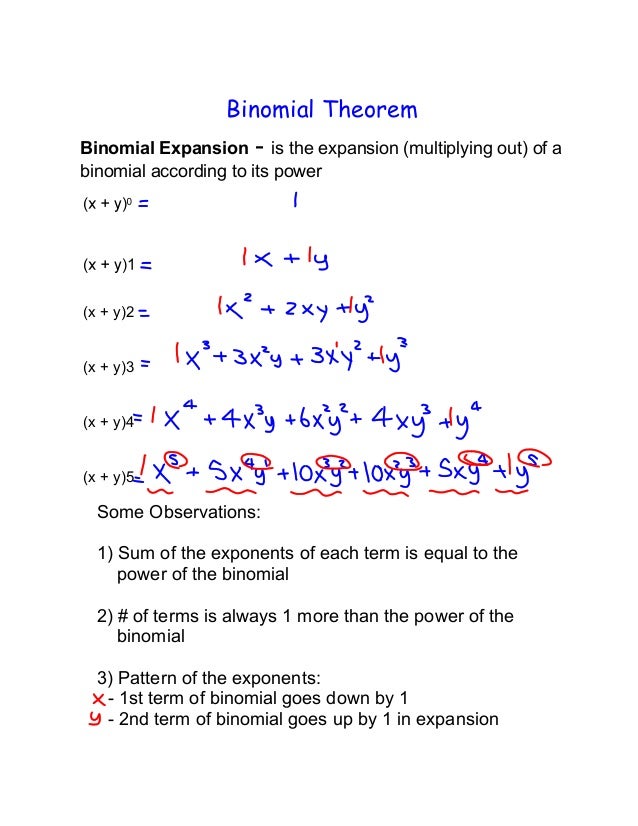



New Day 7 Examples




How To Factorise Using The Identity X Y 3 X3 Y3 3x2y 3xy2 Youtube




Algebra Manipulation Given X Y Xy 3 Evaluate X 3 Y 3 Mathematics Stack Exchange




Expanding Binomials Video Polynomials Khan Academy




Alg2 March28 The Answers




Learn Algebraic Identity Of X Y And X Y In 3 Minutes
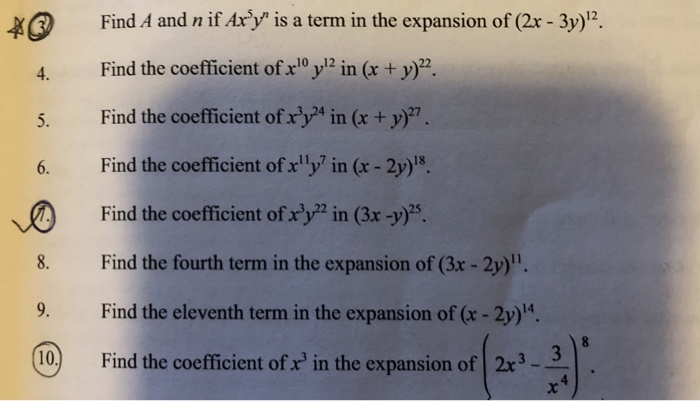



Find A And N If Ary Is A Term In The Expansion Of Chegg Com




The Binomial Theorem Binomial Expansions Using Pascal S Triangle Subsets




How Do You Expand X Y 10 Socratic




Binomial Theorem Properties Terms In Binomial Expansion Examples Pdf
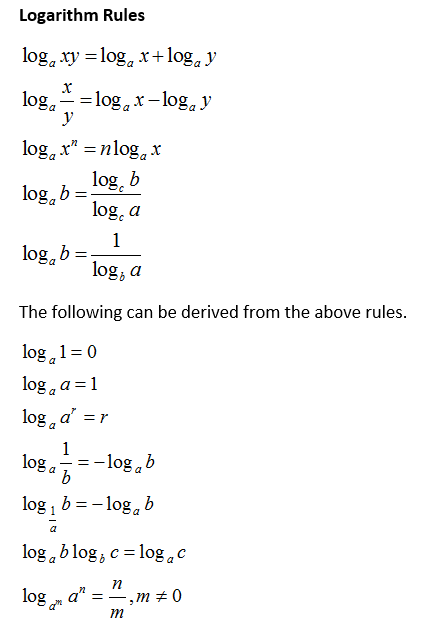



Logarithm Rules Video Lessons Examples And Solutions




Learn Algebraic Identity Of X Y And X Y In 3 Minutes




Binomial Expansion Christober S Technical Weblog




6 8 Pascal S Triangle And The Binomial Theorem Ppt Download




Themathbooklets S2 N5 Expansion Of Linear Expressions




How To Expand Using The Identity X Y 3 X3 Y3 3x2y 3xy2 Youtube
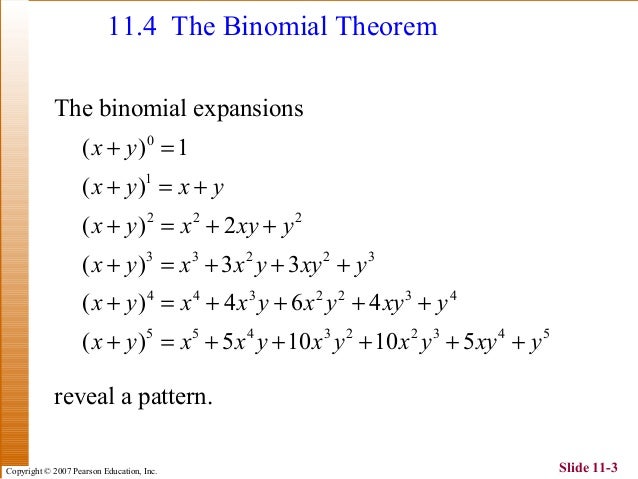



1632 The Binomial Theorem 02




Don T Understand Why This Binomial Expansion Is Not Valid For X 1 Mathematics Stack Exchange



6 8 Pascal S Triangle And The Binomial Expansion Theorem Zeihen Rmhs 605




Expand X Y 3 And X Y 2 Brainly In



Q Tbn And9gcsc77taatmdq7zu7mkjpjo14wu24cor9x8c Pdyonmo Vpvzmuz Usqp Cau




Ex 2 5 6 Write The Following Cubes In Expanded Form Ex 2 5




Myriorama Cards Were Invented In France Around 13




10 Use The Binomial Theorem To Write The Binomial Chegg Com




Expand 1 X Y 3 3 Solve It Fastly Brainly In



1




X Y 2 3 Find The Expansion Of The Following Brainly In



What Is The Answer Of X Y Quora




The Greatest Binomial Coefficient In The Expansion Of X 3 2 Y 2 2 X Y 3 2 12




Example 7 Find Coefficient Of X6y3 In Expansion X 2y 9




Question 1 What Is The Coefficient Of X8y5 In The Chegg Com




Pascal S Triangle And The Coefficients In The Expansion Of Binomials Ck 12 Foundation




Pokemon Tcg Xy Expansion Phantom Forces Out Now




Using Pascal S Triangle How Many Terms Are There In The Expansion Of 2x 4y 12 How Do You Expand And Simplify X Y 6 X Y 6 Quora



Factorials To Binomial Theorem




Expand 1x Y3 3 Maths Questions



What Is The Answer Of X Y Quora



4 The Binomial Theorem
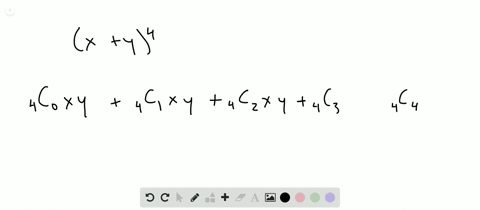



Solved Find The Expansion Of X Y 4 A Using C




Expand And Simplify Binomial Squares 2x 3y 2 Youtube




Find The Coefficient Of X 2y 3z 3 In The Expansion Of Chegg Com




Section 3 3 Binomial Coefficients 30 Points 5 Bonus Chegg Com




Expand Expand Terms Multiply Polynomials With Step By Step Math Problem Solver



1




Expand X X Y 3 3xy X Y
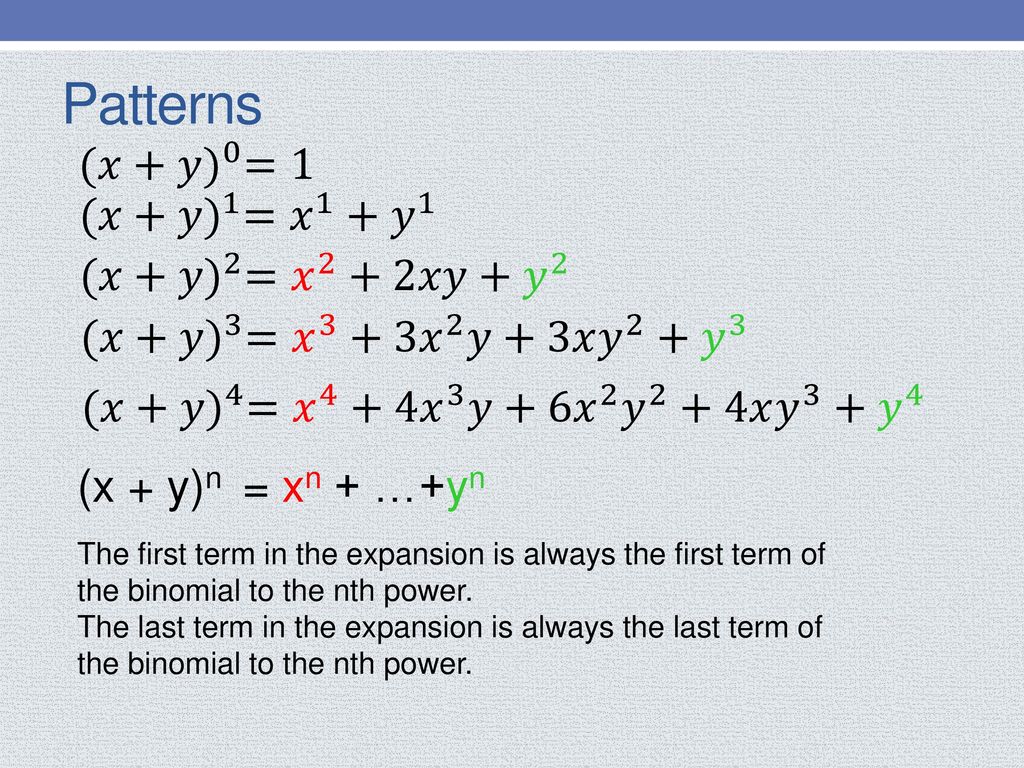



A Quick And Efficient Way To Expand Binomials Ppt Download




Learn Algebraic Identity Of X Y And X Y In 3 Minutes




Expand X Y 3 Solved



2




How Do You Use The Binomial Series To Expand 2x Y 9 Socratic
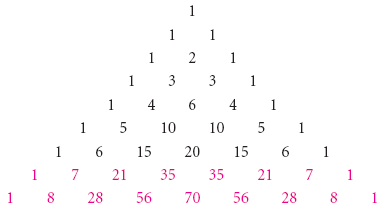



The Binomial Theorem Binomial Expansions Using Pascal S Triangle Subsets




Learn Algebraic Identity Of X Y And X Y In 3 Minutes




What Is The Formula Of Math A B 3 Math Quora




The Binomial Theorem Notes Answers Binomial Theorem Notes Ans3 3 Using Above Expansion X X Y X Y Xy Y X X Y X Y Xy X Y X Y Xy Y The Binomial Theorem Notes Answers Date Rhhs Pdf Document



1




Expansion And Factorisation Bingo Card




Expansion Of X Y 3 Y Z 3 Z X 3 Is What Brainly In




9 5 The Binomial Theorem Lets Look At




Example 7 Find Coefficient Of X6y3 In Expansion X 2y 9




Use The Binomial Theorem To Expand X Y 3 Order Gauthmath




Section 8 5 The Binomial Theorem In This Section You Will Learn Two Techniques For Expanding A Binomial When Raised To A Power The First Method Is Called Ppt Download
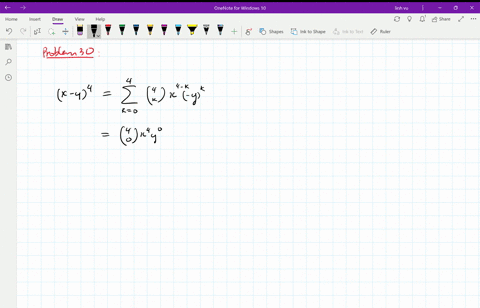



Solved Find The Expansion Of X Y 4 A Using C



0 件のコメント:
コメントを投稿